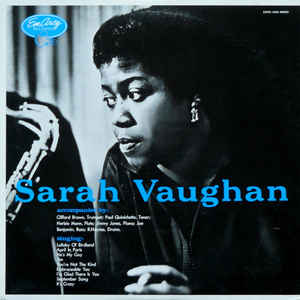Sara Vaughan – Sara Vaughan
Released – 1955
Label – EmArcy
This album from Sarah Vaughan is one of those albums where everything is just right, nothing seems out of place and it feels effortlessly crafted. Enhanced by the excellent trumpet playing of Clifford Brown each song follows into the next to create a wonderful atmosphere of late night jazz clubs.
Though it was not entirely without criticism on its release, I really can’t see that any of the criticism was really deserved and its critical reception upon release was overwhelmingly positive. A contemporaneous review in the music magazine Metronome lamented that “Sarah sounds like an imitation of herself, sloppy, affected and so concerned with sound that she forgets that she is a singer, forgets the lyric of the song itself to indulge in sounds that are meaningless.” To which I say, that’s bollocks.

Tracklist
Lullaby Of Birdland
April In Paris
He’s My Guy
Jim
You’re Not The Kind
Embraceable You
I’m Glad There Is You
September Song
It’s Crazy
10 Interesting Facts About Sarah Vaughan & Her 1950 Self-Titled Debut Album
Sarah Vaughan was one of the most gifted jazz vocalists of all time, known for her incredible vocal range, rich tone, and unmatched control. Her self-titled debut album, Sarah Vaughan (1950), showcased her remarkable ability to blend jazz, blues, and pop, solidifying her reputation as a major force in jazz music.
About Sarah Vaughan:
- Started as a Pianist and Organist
Before becoming a singer, Vaughan played piano and organ at her church in Newark, New Jersey. Her deep musical knowledge allowed her to approach singing with a strong sense of harmony and improvisation. - Discovered at the Apollo Theater
In 1942, she won an amateur night contest at the legendary Apollo Theater in Harlem. This led to her first break—singing with Earl Hines’ band alongside Billy Eckstine, who introduced her to jazz legends like Dizzy Gillespie and Charlie Parker. - Nicknamed “The Divine One”
Vaughan’s voice was so extraordinary that jazz critics and fans gave her the nickname “The Divine One,” highlighting the almost otherworldly quality of her singing. - A Master of Vocal Technique
She had an astonishing range and used complex phrasing, vibrato, and dynamic shifts that set her apart from other singers. Her voice was often compared to a horn instrument because of the way she navigated melodies with precision. - Bridged Jazz and Pop
While she was deeply rooted in jazz, Vaughan was also one of the first jazz singers to successfully cross over into pop music, making her a pioneer in expanding jazz’s mainstream appeal.
About Sarah Vaughan (1950):
- First LP on Columbia Records
Released in 1950, this was her first full-length album for Columbia Records, marking the beginning of her solo career after years of working with big bands. - Orchestral Backing by Miles Davis and His Quintet
Some of the tracks featured a young Miles Davis on trumpet, along with jazz greats like Benny Green (trombone), Freddie Green (guitar), and Budd Johnson (tenor saxophone). The album blended jazz and pop elements, with lush orchestration supporting Vaughan’s vocals. - A Mix of Standards and Romantic Ballads
The album contained jazz standards such as “East of the Sun (and West of the Moon),” “Nice Work If You Can Get It,” and “Come Rain or Come Shine.” Vaughan’s interpretations of these songs became definitive versions for future jazz singers. - Showcased Her Signature Style
This album introduced the world to Vaughan’s ability to effortlessly switch between rich, warm lower registers and soaring high notes, a skill that made her one of jazz’s most versatile vocalists. - A Jazz Landmark
While Vaughan would go on to record many other groundbreaking albums, her 1950 self-titled debut remains a landmark, capturing her early genius and setting the stage for one of the most influential careers in jazz history.


Leave a Reply